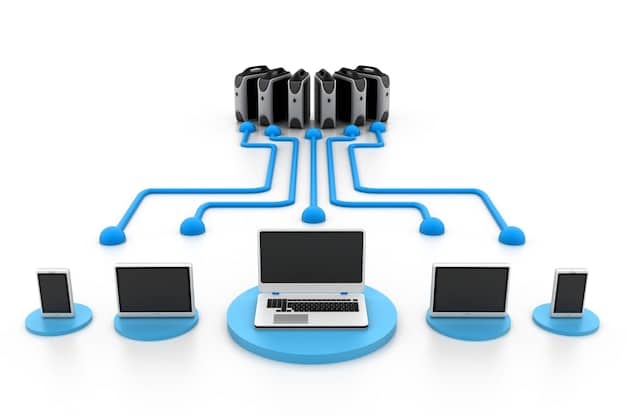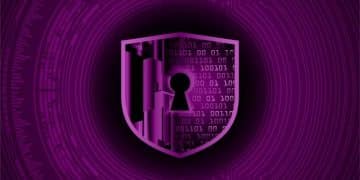Insider Threat Detection: US Strategies to Cut Data Breaches by 40%

Insider threat detection is crucial for US organizations aiming to reduce data breaches. By implementing focused strategies, companies can significantly mitigate risks posed by internal actors and achieve up to a 40% reduction in security incidents.
In today’s digital landscape, data breaches are a persistent threat. While external attacks often dominate headlines, a significant portion of these incidents stem from within organizations. Insider threat detection is no longer a luxury but a necessity for US-based companies looking to safeguard their sensitive information and maintain a competitive edge.
Understanding the Scope of Insider Threats in the US
The threat landscape is constantly evolving, with insider threats becoming increasingly sophisticated and difficult to detect. Understanding the nature and prevalence of these threats is the first step toward developing effective mitigation strategies for US organizations.
Defining Insider Threats
Insider threats encompass a range of malicious or unintentional actions carried out by employees, contractors, or business associates who have authorized access to an organization’s systems, data, or facilities. These threats can be broadly categorized into:
- Malicious Insiders: Individuals who intentionally cause harm, steal data, or disrupt operations for personal gain, revenge, or ideological reasons.
- Negligent Insiders: Employees who unintentionally expose the organization to risk through carelessness, lack of training, or disregard for security policies.
- Compromised Insiders: Insiders whose credentials have been stolen or compromised by external actors, allowing attackers to gain unauthorized access to the organization’s systems.
Identifying the type of insider threat you may be facing helps to tailor your response and prevention methods.

The Impact on US Businesses
The impact of insider threats on US businesses can be devastating, resulting in significant financial losses, reputational damage, legal liabilities, and operational disruptions. According to recent studies:
- Insider-related incidents can cost millions of dollars per year, per incident.
- Businesses face regulatory fines if breaches expose Personally Identifiable Information (PII).
- Loss of intellectual property can negate years of research and development.
In conclusion, insider threats are a serious problem that can have a major impact on businesses. Implementing robust detection and response plans is critical to protect your organization.
Building a Robust Insider Threat Detection Program
Creating an effective insider threat detection program requires a holistic approach that encompasses technology, policies, procedures, and training. This program serves as the backbone for proactively identifying and mitigating potential risks before they escalate.
Establishing Clear Policies and Procedures
A well-defined set of policies and procedures is essential for setting expectations, defining acceptable behavior, and outlining the consequences of non-compliance. These policies should address areas such as:
- Data access and usage policies
- Acceptable use policies for company resources
- Incident reporting procedures
Enforcement of these policies is just as important as the crafting itself. Make sure that employees are aware of risks and are held accountable.
Implementing Security Technologies
Implementing advanced technologies can significantly enhance your ability to detect and respond to insider threats. These technologies include:
- User and Entity Behavior Analytics (UEBA): UEBA solutions leverage machine learning and behavioral analytics to establish baselines of normal user behavior and identify anomalies that may indicate malicious activity.
- Data Loss Prevention (DLP): DLP solutions prevent sensitive data from leaving the organization’s control by monitoring data in transit, at rest, and in use.
- Security Information and Event Management (SIEM): SIEM systems collect and analyze security logs from various sources to provide a comprehensive view of security events across the organization.
These technologies provide the tools needed for a proactive defense against insider threats.
In conclusion, a robust insider threat detection program, built with clear policies and cutting-edge technology, is vital for any organization looking to protect itself.
Leveraging User and Entity Behavior Analytics (UEBA)
UEBA has emerged as a game-changer in the field of insider threat detection. By continuously monitoring and analyzing user and entity behavior, UEBA solutions can identify subtle anomalies that may indicate malicious intent or compromised accounts.
How UEBA Works
UEBA solutions employ advanced algorithms and machine learning techniques to establish baselines of normal user behavior, taking into account factors such as:
- Access patterns
- Data usage
- Communication patterns
When a user deviates from their established baseline, the UEBA system generates an alert, triggering further investigation.

Real-World Applications of UEBA
UEBA can be applied to a wide range of insider threat scenarios, including:
- Detecting data exfiltration attempts
- Identifying compromised accounts
- Spotting privilege escalation
The adaptability of UEBA makes it a critical asset in a variety of business sectors. Consider its implementation to safeguard your organization’s future.
In conclusion, UEBA has revolutionized insider threat detection through continuous learning and adaptive security responses. Staying ahead requires embracing innovations like UEBA.
Implementing Data Loss Prevention (DLP) Strategies
Data Loss Prevention (DLP) is a critical component of any comprehensive insider threat detection program. DLP solutions help organizations identify, monitor, and protect sensitive data to prevent unauthorized disclosure or exfiltration.
Key Features of DLP Solutions
DLP solutions offer a range of features designed to protect sensitive data, including:
- Content inspection
- Data classification
- Incident response
They function to prevent sensitive data from leaving the organization’s control, whether intentionally or unintentionally.
Best Practices for DLP Implementation
To maximize the effectiveness of DLP, organizations should follow these best practices:
- Identify and classify sensitive data
- Define clear policies for data handling
- Provide training for employees
Properly implemented, a strong DLP system can greatly reduce your business’s exposure to insider threats.
In conclusion, DLP strategies are essential for safeguarding data and ensuring compliance. Prioritizing data protection measures is key to security.
Enhancing Monitoring and Logging Practices
Comprehensive monitoring and logging practices are foundational for effective insider threat detection. By capturing and analyzing relevant security events, organizations can gain valuable insights into user behavior and identify potential threats.
Essential Monitoring Practices
Essential monitoring practices include:
- Endpoint monitoring
- Monitoring network traffic
- Monitoring cloud activity
These can produce a multi-layered view of activities within your organization.
Log Management and Analysis
Log management and analysis are critical for identifying suspicious activities and investigating security incidents. Organizations should:
- Centralize log collection
- Implement log retention policies
- Use SIEM tools
This allows for more accurate evaluation and response to threats.
In conclusion, effective monitoring and logging practices are foundational for insider threat detection. Implementing these practices can substantially improve security posture.
Awareness and Training Programs for US Employees
While technology plays a crucial role in insider threat detection, it’s equally important to educate and empower your employees to become active participants in the security process. Awareness and training programs are essential for fostering a security-conscious culture within the organization.
Creating a Security-Conscious Culture
Creating a security-conscious culture begins with raising awareness of the risks associated with insider threats. Employees should be trained to:
- Recognize phishing scams and social engineering attacks
- Handle sensitive data securely
- Report suspicious activity
Equipping employees with knowledge helps build a solid first line of defense.
Regular Training Exercises
Regular training exercises are essential for reinforcing security concepts and testing employees’ ability to respond to potential threats. These exercises should include:
- Simulated phishing attacks
- Tabletop exercises
- Role-playing scenarios
Such training keeps your employees sharp and security ready.
In conclusion, investing in awareness and training programs is crucial for bolstering internal security. Preparedness and awareness are invaluable in threat prevention.
| Key Point | Brief Description |
|---|---|
| 🛡️ Policy Clarity | Establish robust data and usage policies to set clear expectations. |
| 🤖 UEBA Use | Employ UEBA for behavioral analysis and anomaly detection. |
| 🚨 DLP Setup | Implement DLP strategies to monitor and secure sensitive data. |
| 🧑🏫 Employee Training | Provide regular training to enhance security awareness. |
Frequently Asked Questions
▼
An insider threat refers to the risk posed by individuals within an organization, such as employees or contractors, who have access to sensitive data and systems. This threat can stem from malicious intent, negligence, or compromise.
▼
UEBA (User and Entity Behavior Analytics) leverages machine learning to establish a baseline of normal user behavior. It identifies and flags anomalies that deviate from this baseline, potentially indicating a threat.
▼
An effective Data Loss Prevention (DLP) strategy includes identifying and classifying sensitive data, implementing clear data handling policies, continuously monitoring data movement, and providing regular training to employees.
▼
Employee training is crucial because it enhances awareness of security risks, educates on best practices, and encourages the reporting of suspicious behavior. A well-trained employee is a critical first line of defense.
▼
Insider threat detection strategies should be regularly updated, ideally at least annually, to adapt to evolving threats and changes within the organization. Continuous monitoring and periodic assessments are essential.
Conclusion
Effective insider threat detection requires a layered approach, combining robust technologies, clear policies, and engaged employees. By implementing the strategies outlined above, US organizations can significantly reduce their risk of data breaches and maintain a strong security posture.





